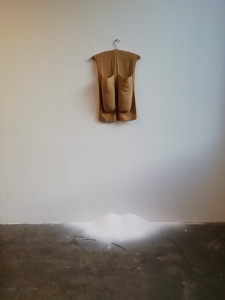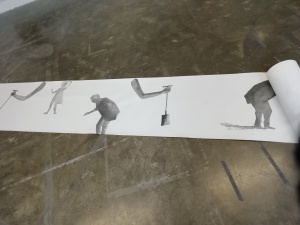A Salt House is everywhere

e.g. it is a hotel in Bangor, it is one of the exciting Scottish folk bands.
The significant one does not exist anymore, it is visible on one of the black and white photographs taken by Kelly’s parents in the early 1960s. Visual perception has an immediacy that is absent from hearing. It also grants a freedom in which order an image is observed. The old photograph and its translation into a drawing disclose the image directly and immediately.
The interplay of presence and absence possibly sprouted intention to protect negative space that manifests in the above drawing as white. As salt. The trees do not respond to actual photographs. Kelly says she made them up to obtain the dynamic contrast and believable space. That apprehends truth in the sense of awakening.
Salt has been, and is, a valuable commodity, associated with health and preservation. Do you have in your childhood memories a story about salt being more valuable than gold? Salt is deemed to be more valuable because living creatures (people and animals) need it more than they need gold.
At the Project Space entrance there is a salt on the floor as if getting there after someone emptied the cloth pockets on the hanger above. Domestic, functional pockets denoting a class of their maker and user, and making a fragment of memories physically present. Note, how the salt lights up the wall and the floor, almost as if it mimicked a universe. The textile receptacle wrestles into any memory a viewer may have of old domestic objects, that are lightheartedly disposed of and replaced by some plastic.

In an interview with academic and critic Carol Becker, Okwui Enwezor once stated:
“We are grappling with very difficult historical issues that concern not only how we live and produce art and culture, but also how we experience it and our place as citizens within the global community.” The Salt House installation manifests an honest and unpretentious embodiment of those thoughts while doing it with sincere respect for personal memories. A chaste respect for memories to deteriorate or even disappear perhaps triggered the need to preserve them.
Sharon Kelly has made art about her life, as if art were the best receptacle for lived experiences.
The way the paper goes in and out of the mangle, empty in, with images out, the real found object assumes significance. Mangle used to be every day object in European households – part of prolonging use of clothes, keeping them clean for another use. Thus it offers here, in an analogy, to keep the memory for another day, for the future, also clean. Mangle being similar to a printing machine also visually alliterates narrative role in memories, histories.
The sunlight coming from outside, although unplanned, by chance, connects the drawings to the actual Salt House position near the rail track, memory of which metamorphosed into the ribbon of paper. The mangle is like the train stop for the Salt House.

Above, the sun rays added layers of meaning – expected from art with lens based ancestors.
Without the sun rays… it is more fragile, just on this side of presence. Drawings of shadows, imprints of remembered siblings, childhood memories. Sincerely private, yet open to sharing.

Art viewing is a private, secret process.
Many today share the power of sociology and history as a convenient tool to justify funding of art. However, history, be it personal or social, happens now as it did at Lascaux cave or in that new find in Borneo.
During her MFA students years, Sharon Kelly, focused on charcoal drawings of motives from her own life, creating in lens based media later on. She used to draw on discarded linen, on men’s discarded shirts. Here, decades later, she chose expensive paper as the ground and gave it a strong role of meaningful emptiness. Paper is everyday, drives out the artist’s self-consciousness – perhaps. The harder I try to nail this down the more it escapes. Picasso also shared the importance of paper, saying that ” it gives him high degree of flexibility. Paper is tear-able, relatively unimportant, bendable… The figures in the Salt House vibrate with sincerity – yet keep their secrets resolutely intact.

The paper carries them from the mangle into the space, the charcoal hesitating between life and disappearing memory. Memory is not of this world. It floats between here and then.
The significance of the “empty” in comparison with the “full” – has to do with the poetic tropes, as well as with an optic law.

The significance of black hue (charcoal) in Kelly’s oeuvre cannot be overstated and overlooked.
She shares the trust that black contains all other hues, a belief which is not limited to one culture. A search for light and the use of black is the driving force in Mohammad Omar Khalil’s work (b 1936 Khartoum). He says: “In blackness, I see degrees and shades of rich, complicated colour, more intense than in other colours, roaring and loud.” The use of black in his etchings focused on definition of dominant object in the composition be it by contrast or graduation.

Twentieth century art replaced descriptive role of black on white ground by “coming between the light and dark”(Donald Judd).
In the print below the white is both behind and in front of the burning black.

That kind of “in-between” is not occurring when Vallotton paints the composition in red and black under the title The Lie (1897), although the subject and composition share appearance.

The Salt House is a tender attempt to accomplish resurrection of appearance without describing it, to re-create it anew as a new real. It is more often used for invented motives like this Picasso.

The Salt House shares with Picasso the ability and resolve to define the form (the subject) as absence enveloped in black. It imprints itself in white as if on a black soft ground to guard the power of intimacy rooted in a belief.

Darkness has been described as a pregnancy of tiny articles like fine ashes, each particle luminous as a rainbow. The novelist Junichiro Tanizaki in a 1933 essay, In Praise of Shadows, living in Kyoto at the time, worked from a low desk gazing out the sliding doors toward the garden. “We find beauty not in the thing itself but in the patterns of shadows, the light and the darkness, that one thing against another creates.” Hence the invented trees – “making trees up”.

If black is given the role of creation, the white is the memory, a pathway to memory. The black evokes nature, life, while the white settles for the man made, for absence, for intimacy of scrutiny what is remembered.
On the ribbon of the large scale paper flowing from the “misuse” of an old mangle, the white becomes the “environment”, a ground, for each fragment of recalled past.


Only one drawing is presented on its own, in its own “frame”, possibly reminiscing on the found photograph.

In a short film by Éanna Mac Cana ( https:// http://www.youtube.com/…) Sharon Kelly reminisces on the respect for memory, that it needs protection: if your memory is not shared it dies with you.
Slavka Sverakova,White Cottage, January 28, 2020